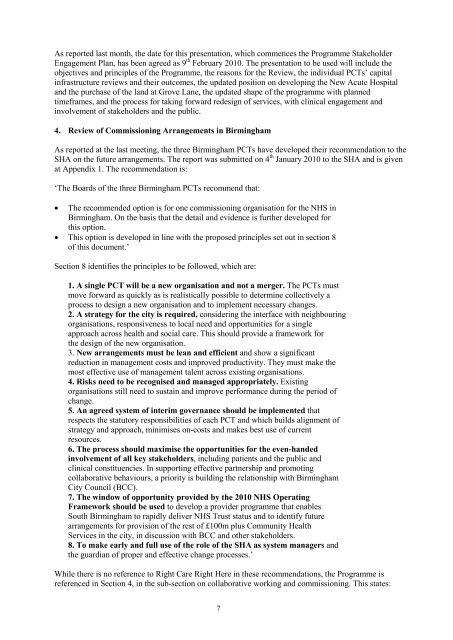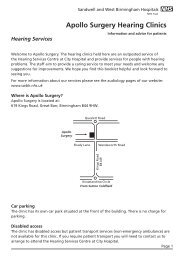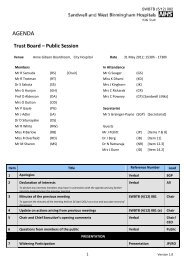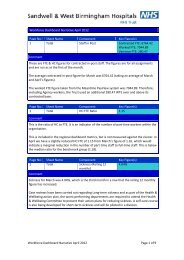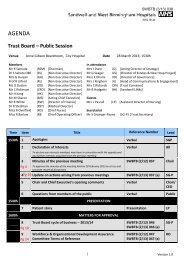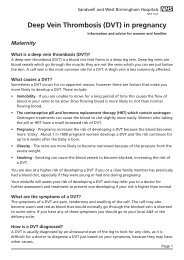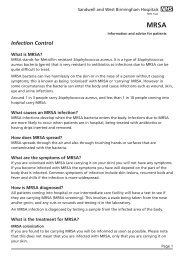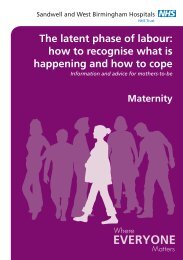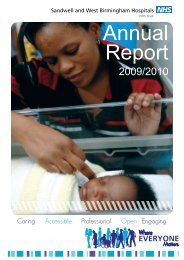Trust Board Febuary 2010 - Sandwell & West Birmingham Hospitals
Trust Board Febuary 2010 - Sandwell & West Birmingham Hospitals
Trust Board Febuary 2010 - Sandwell & West Birmingham Hospitals
You also want an ePaper? Increase the reach of your titles
YUMPU automatically turns print PDFs into web optimized ePapers that Google loves.
As reported last month, the date for this presentation, which commences the Programme Stakeholder<br />
Engagement Plan, has been agreed as 9 th February <strong>2010</strong>. The presentation to be used will include the<br />
objectives and principles of the Programme, the reasons for the Review, the individual PCTs’ capital<br />
infrastructure reviews and their outcomes, the updated position on developing the New Acute Hospital<br />
and the purchase of the land at Grove Lane, the updated shape of the programme with planned<br />
timeframes, and the process for taking forward redesign of services, with clinical engagement and<br />
involvement of stakeholders and the public.<br />
4. Review of Commissioning Arrangements in <strong>Birmingham</strong><br />
As reported at the last meeting, the three <strong>Birmingham</strong> PCTs have developed their recommendation to the<br />
SHA on the future arrangements. The report was submitted on 4 th January <strong>2010</strong> to the SHA and is given<br />
at Appendix 1. The recommendation is:<br />
‘The <strong>Board</strong>s of the three <strong>Birmingham</strong> PCTs recommend that:<br />
• The recommended option is for one commissioning organisation for the NHS in<br />
<strong>Birmingham</strong>. On the basis that the detail and evidence is further developed for<br />
this option.<br />
• This option is developed in line with the proposed principles set out in section 8<br />
of this document.’<br />
Section 8 identifies the principles to be followed, which are:<br />
1. A single PCT will be a new organisation and not a merger. The PCTs must<br />
move forward as quickly as is realistically possible to determine collectively a<br />
process to design a new organisation and to implement necessary changes.<br />
2. A strategy for the city is required, considering the interface with neighbouring<br />
organisations, responsiveness to local need and opportunities for a single<br />
approach across health and social care. This should provide a framework for<br />
the design of the new organisation.<br />
3. New arrangements must be lean and efficient and show a significant<br />
reduction in management costs and improved productivity. They must make the<br />
most effective use of management talent across existing organisations.<br />
4. Risks need to be recognised and managed appropriately. Existing<br />
organisations still need to sustain and improve performance during the period of<br />
change.<br />
5. An agreed system of interim governance should be implemented that<br />
respects the statutory responsibilities of each PCT and which builds alignment of<br />
strategy and approach, minimises on-costs and makes best use of current<br />
resources.<br />
6. The process should maximise the opportunities for the even-handed<br />
involvement of all key stakeholders, including patients and the public and<br />
clinical constituencies. In supporting effective partnership and promoting<br />
collaborative behaviours, a priority is building the relationship with <strong>Birmingham</strong><br />
City Council (BCC).<br />
7. The window of opportunity provided by the <strong>2010</strong> NHS Operating<br />
Framework should be used to develop a provider programme that enables<br />
South <strong>Birmingham</strong> to rapidly deliver NHS <strong>Trust</strong> status and to identify future<br />
arrangements for provision of the rest of £100m plus Community Health<br />
Services in the city, in discussion with BCC and other stakeholders.<br />
8. To make early and full use of the role of the SHA as system managers and<br />
the guardian of proper and effective change processes.’<br />
While there is no reference to Right Care Right Here in these recommendations, the Programme is<br />
referenced in Section 4, in the sub-section on collaborative working and commissioning. This states:<br />
7


